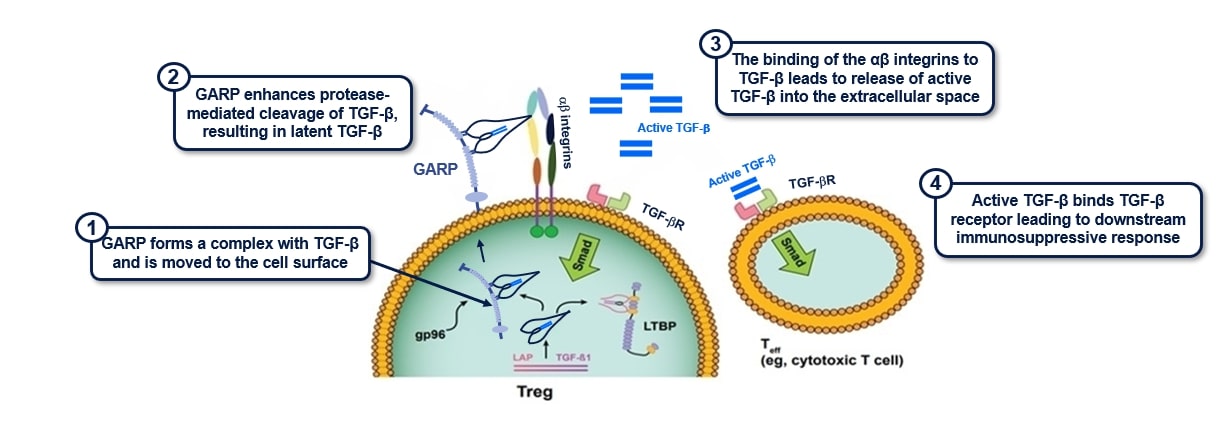GARP - TGF-β1
OVERVIEW
Dysregulated transforming growth factor-β1 (TGF-β1) signaling may play a role in cancer immune escape and resistance to immune activating agents. TGF-β1 signaling in the tumor microenvironment (TME) represses the antitumor function of various immune cell populations, including T cells and natural killer cells. TGF-β1 facilitates regulatory T cells' (Tregs) suppression of effector CD8+ T cell responses.1-4
- TGF-β1 is a pleiotropic cytokine that plays important roles in numerous aspects of biological processes such as cell proliferation, development, apoptosis, fibrosis, angiogenesis, wound healing, and cancer, in addition to other processes.1
- Glycoprotein-A repetitions predominant (GARP) has been identified as a critical regulator of TGF-β1 expression and activation. By binding to latent TGF-β1, GARP acts as a docking receptor that concentrates latent TGF-β on the cell surface and enhances its final activation.1
- On the cell surface, GARP-latent TGF-β1 complex associates with integrins (αVβ6 and αVβ8) to release active TGF-β1 . Mature TGF-β1 interacts with TGF-β receptors on the cell surface.1
Adapted from Metelli A, et al. 2018.1 http://creativecommons.org/licenses/by/4.0/ for CC BY 4.0
IMPLICATIONS IN CANCER
Based on in vitro studies, transforming growth factor (TGF)-β signaling has been shown to induce an immunosuppressive tumor microenvironment (TME) and promote tumor progression.1 Glycoprotein A repetitions predominant (GARP) is a membranebound receptor that complexes with latent TGF-β1 and plays a vital role in the immunosuppressive function of regulatory T cells (Tregs).5 In addition to Tregs, GARP–TGF-β1 is expressed on other cells such as macrophages and tumor cells.6 Data from mouse models demonstrated that combined targeting of GARP–TGF-β1 and programmed cell death protein 1 (PD-1) improved antitumor effects compared with anti–PD-1 alone.3
Oncogenic Expression
- GARP favors tumor immune evasion and supports TGF-β1-driven cancer cell growth and dissemination by regulating the innate and adaptive immune system.1
- GARP protein is expressed by human breast cancer, lung cancer, and colon cancer cells; higher GARP expression correlates with worse clinical outcome.1
- Active TGF-β1 impairs adaptive anti-tumor immunity by directly inhibiting the clonal expansion and cytotoxicity of the CD8+ cytotoxic T cells (CTLs).1
- Blocking TGF-β1 production by Tregs induces regression in immunotherapy-resistant mouse tumors.4
- These effects are due to increased effector function of anti-tumor CD8+ cells.4
- Metelli A, et al. Immunoregulatory functions and the therapeutic implications of GARP-TGF-β in inflammation and cancer. J Hematol Oncol. 2018;11:24.
- Metelli A, et al. Surface Expression of TGFb Docking Receptor GARP Promotes Oncogenesis and Immune Tolerance in Breast Cancer. Cancer Res. 2016;76(24):7106-7117.
- de Streel G, Bertrand C, Chalon N, et al. Selective inhibition of TGF-β1 produced by GARP-expressing Tregs overcomes resistance to PD-1/PD-L1 blockade in cancer. Nature communications. 2020;11(1):1-5.
- Carrillo-Gálvez AB, Quintero JE, Rodríguez R, et al. GARP promotes the proliferation and therapeutic resistance of bone sarcoma cancer cells through the activation of TGF-β. Cell Death Dis. 2020;11:985.
- Stockis J, et al. Role of GARP in the activation of latent TGF-β1. Mol BioSyst. 2017;13:1925-35.
- Zimmer N, et al. GARP as a Therapeutic Target for the Modulation of Regulatory T Cells in Cancer and Autoimmunity. Front Immunol. 2022;13:928450.



